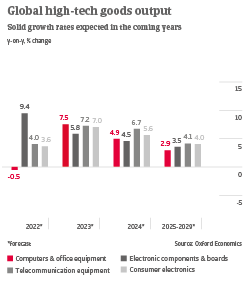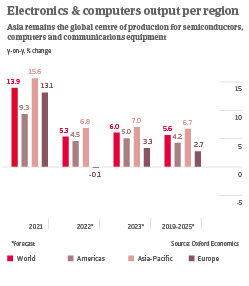ICT is expected to be among the fastest growing sectors in manufacturing, driven by accelerating digitalisation and industrial automation


Short-term outlook: strengths and growth drivers
- Resilient sector performance: ICT businesses have largely expanded production and sales during the pandemic. In 2021, main subsectors recorded double-digit output growth rates: computers up 14.2%, electronic components up 19.6% and telecommunications up 10.4%.
- Financial strength: The profit margins of ICT businesses have increased in many key markets, and most companies have been able to pass on higher prices for semiconductors to end-customers so far.
- Chip availability: While semiconductor supply still remains tight for the time being, the worst of the chip shortage seems to be over because chip producers are increasing supply. Major investments to ramp up chip production as of 2024 are underway. Output growth of chip-consuming sectors such as computers, telecommunications equipment and consumer electronics should accelerate again in 2023.
Short-term outlook: downside risks
- Persistent high inflation and interest rates: Longer-lasting high inflation in the US and in Europe could further erode real incomes, leading to decreasing sales of consumer electronics. Sharply rising interest rates and deteriorating investor sentiment could weigh on ICT investments of businesses in other industries.
- Long Covid: Another wave of the pandemic and subsequent lockdowns could negatively affect ICT investments from businesses and consumers alike. Ongoing lockdowns in China due to Beijing´s zero-Covid policy could severely impact ICT supply chains around the globe.
- War in the Ukraine: Ukraine is the world’s largest producer of semiconductor-grade neon (a bi-product from steelmaking). While silicon remains the primary component of chips, neon gas is highly utilized in the etching of silicon A longer-lasting war could lead to neon gas shortages if chipmakers are unable to source key raw materials from elsewhere. This would impact (still strained) semiconductor production and supply.
Mid-and long-term outlook: strengths and growth drivers
- High-tech expansion. ICT electronics is an innovative and technology-driven industry. In particular, the semiconductor segment is highly value-added -- and provides robust margins for manufacturers. Expanding semiconductor production is a strategic target in both the US and the EU. US Congress recently passed a “Chips Act” worth USD 52 billion in order to prop up domestic leading edge semiconductor production. In February 2020, the EU Commission announced it will invest a total of EUR 45 billion in chip-related R&D, infrastructure and production until 2030.
- Solid future growth rates. Over the coming years, ICT/electronics performance prospects are benign. The industry is expected to be among the fastest growing sectors in manufacturing, driven by accelerating digitalisation, industrial automation, and increased demand for semiconductors from new growth segments like electric vehicles.
Mid- and long-term outlook: constraints and downside risks
- Market saturation. In some advanced economies, the market for certain ICT products (e.g. personal computers, tablets and smartphones) is nearing saturation, which affects growth prospects.
- US-China tensions. Trade issues have spilled over to technology, with both the Trump and Biden administrations imposing regulations to prevent Chinese companies from acquiring US semiconductor manufacturing technologies and equipment. Both sides, meanwhile, perceive high-tech leadership as a strategic asset. A further deterioration of the Sino-US relationship could negatively affect global ICT/electronics supply chains and potentially lead to technological divergences (e.g. in the 5G deployment) and lower productivity.
- Taiwan issue. Given the global importance of Taiwanese semiconductor production, an escalation of the current tensions in the Taiwan Strait could severely affect chip supply for chip-consuming ICT segments and other industries across the world.
Свързани документи

Industry Trends ICT 2022
986KB PDF
